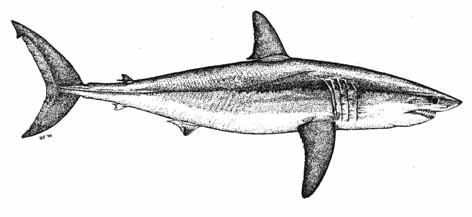Shortfin Mako Shark (Isurus oxyrinchus)

Rafinesque, 1810.
| Fr: |
Taupe bleu; L'oxyrhine |
| Sp: |
Marrajo dientuso; Marrajo; Solraig
(Catalunya); Solroig; Marrajo Criole (Azorean dark
variety) |
| It: |
Squalo mako; pisci tunnu (Sicily); meanto
(Liguria); oxyrhinna; ossirina; Cranicia (Ancona) |
| Ma: |
Pixxiplamtu;
Pixxitondu |
Diagnosis
A supremely streamlined, spindle-shaped shark with a long,
pointed snout, large eyes without nictitating eyelids and highly
visible dentition (even when the jaws are virtually closed); teeth
long, reverse-curved and dagger-like without serrations or basal
cusplets. Crescent-shaped caudal fin; strong caudal
keels but without secondary keels on the ventral lobe.
First dorsal fin rather tall; apex somewhat rounded; origin behind
the pectoral fin free-tips. Pectoral fins shorter than the
head (i.e., distance from snout to 5th gill slit). Anal fin
minute, its origin about midway beneath the base of the equally
small 2nd dorsal fin. Colour cobalt blue on the upper dorsum,
meeting metallic steel-blue at a strong line of demarcation on the
upper flanks; undersides white with a black blotch in the axil
of the pectoral fin; the anterior and posterior pectoral fin margins
in newborns is frequently whitish. At all size-classes the
junction of latero-dorsal steel-blue and ventral white pigmentation
is not as clearly defined as in the demarcation line of Carcharodon
carcharias; however, after death the striking
upper-body pigment quickly fades to grey and may appear
superficially similar to that of white sharks. A notably dark
form of mako, apparently of this species, is endemic to Azorean
waters and has large areas of dorsal pigment intruding
latero-ventrally at the snout and posterior body, rather similar in
guise to the longfin mako, Isurus paucus.
Size
To ca. 390 cm; generally to 340 cm and commonly to 280cm; size at
birth 60 to 70 cm.
Status and Distribution
N.E. Atlantic: Abundant, common or occasional;
cosmopolitan but with a marked seasonal bias favouring high summer
occurrences in northern parts of range (where these sharks are
sympatric with superficially-similar porbeagles, Lamna
nasus). In these circumstances, shortfin makos may occur
sporadically, or with localised, short-term abundance, in north
European waters off Ireland (mainly southern coasts), England
(Cornwall, Devon and Scilly Isles; occasionally straying to Bristol
Channel and Wales; very rarely penetrating eastwards of the Isle of
Wight and extremely scarce nomads within the North Sea); infrequent,
nominal outliers reported as far north as Scottish waters and Norway
although the majority of annual occurrences are essentially limited
south of Latitude 50N in summer and Lat. 45N at colder times of the
year. Frequent or even abundant from this latitude southwards;
Bay of Biscay, Portugal, Spain and southwards to the tropics,
including all oceanic islands. In all parts of range,
abundance of this oceanic shark generally increases as a function of
greater distance offshore.
Mediterranean: Common and
cosmopolitan within waters above 16C; ranges throughout the
Mediterranean basins, principally in offshore waters. Regularly
encountered in Southern Spanish waters, particularly from Valencia
southwards; occasionally along the Côte d¹Azur and more often
in the Ligurian Sea and environs; frequent in southern-central
Mediterranean (Sicily, Isole Pelagie and Malta) and Ionian Sea; less
common in the Adriatic and rarely encountered in that region from
Ancona northwards. Occurs within the entire Aegean Sea; Crete,
Cyprus and Turkey, but scarcer in extreme south-eastern waters.
Biology
A highly active, usually offshore pelagic species, occurring from
the surface down to at least 150 m. Found in blue waters
far from land but occasionally closer inshore, particularly near
islands or islets (e.g., Filfla Islet in Malta) lying adjacent to
deepwater drop-off¹s and near coastal reefs rich in prey-fish (e.g.,
Manacles, Cornwall). The swiftest of all sharks, shortfin
makos are major predators of a wide range of pelagic fish, including
mackerel, scad, tunas, bullet tunas, bonito and swordfish;
occasionally taking demersal fish, other sharks, rays, cephalopods
and apparently marine turtles. It has been suggested that
adult makos sporadically attack free-swimming dolphins and this
thesis appears validated on the basis of an amateur video, taken in
Pacific waters, that shows a moribund spotted dolphin (tail-stock
almost severed) just after an attack by a shark. The video
captures a few frames of a very large shortfin mako circling the
bleeding dolphin. These sharks will also scavenge upon longlined and
netted fish; also cetaceans (dolphins); large specimens have
been observed to attack harpooned adult swordfish in the Straits of
Messina. Their predatory relationship to swordfish is poorly
known, but it is clear from regional data that these sharks can find
their prey a dangerous adversary, as demonstrated by recent cases
(at Ganzirri and Isola Lipari, Sicily) of makos stranding dead or
moribund with amputated swordfish bills impaled in their gills and
heads. These cases have coincided with the late spring - early
summer spawning cycle of swordfish, perhaps suggesting that shortfin
makos target these fish at this time whilst the prey is vulnerable
at the surface but are nevertheless prone to aggressive defensive
attack by their quarry. Interestingly, a form of mako endemic to
Azorean waters has unusually dark ventral pigmentation (see
diagnosis, above) but in all other respects appears identical to
I. oxyrinchus. Moreno and Moron (1992) give a lengthier
analysis of this interesting variation. Further genetic
analysis of these so-called "Marrajo criole" may yield interesting
results. Data compiled by the National Marine Fisheries
Service (NMFS) at Rhode Island, USA, has given information on the
movements and possible population-structure of Northern Atlantic
shortfin mako stocks. Trans-Atlantic recaptures are nominal,
inferring limited interchange between what appear to be two distinct
western and eastern populaces. This inference has been further
supported by genetic sampling of animals from both sides of the
Atlantic. Ovoviviparous; Litter size ranging 4 to 16. Females
mature at ca. 280cmTL and males at ca. 195cm.
The Shark Trust, 36 Kingfisher Court, Hambridge Road, Newbury, Berkshire, RG14 5SJ, UK.
Tel(+44) 01635 551150, Fax(+44) 01635
550230
|